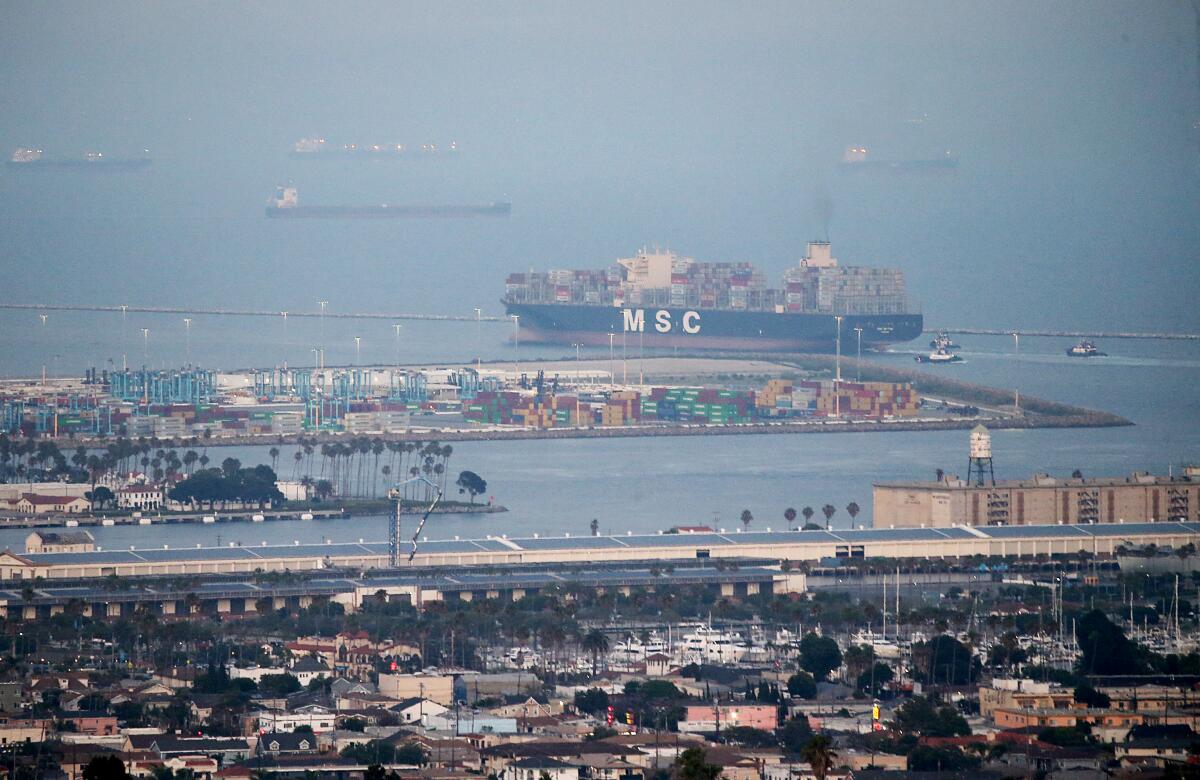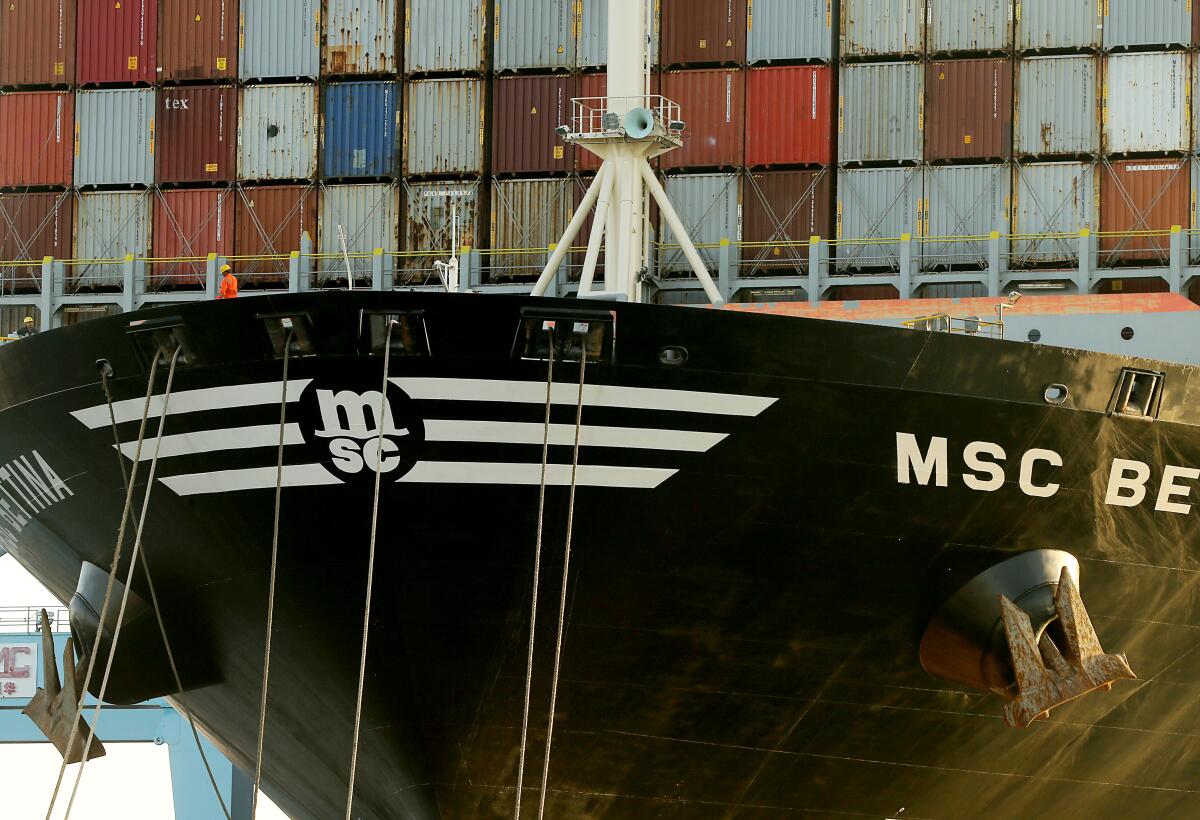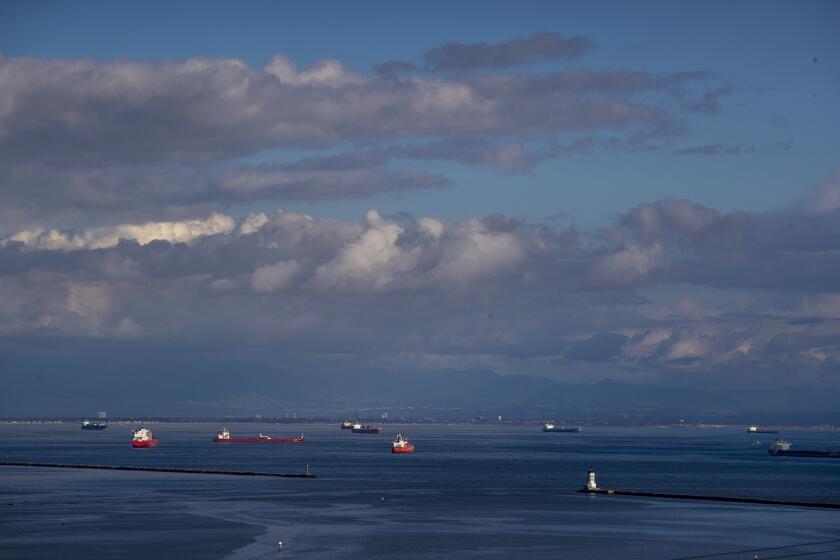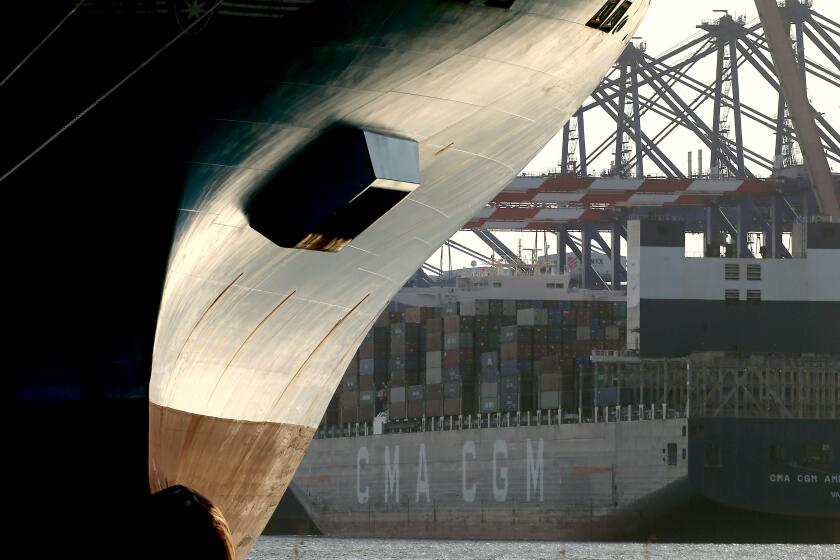L.A. doesn’t love N.Y. over ‘We’re No. 1’ seaport claims

- Share via
It’s good to be No. 1.
That’s the spot held for more than two decades by the Los Angeles and Long Beach ports, a combined international trade powerhouse that moves nearly 40% of the products imported from Asia to U.S. stores and factories. Tens of thousands of jobs across Southern California depend on a steady stream of imports and exports through San Pedro Harbor.
Despite pandemic supply chain snafus, an enormous floating traffic jam of ships and a dockworker contract dispute at various points during the last three years, the neighboring ports have moved enough big steel cargo boxes to stay at the top of the import-export heap. Along with bragging rights comes the ability to attract more business, more investment and more jobs.

So it came as a bit of a surprise down on the docks late last year when the East Coast rival ports of New York-New Jersey blasted a series of monthly alerts in which officials said their complex was the busiest cargo container handler in America. Then, in April, the Port Authority of New York and New Jersey issued a news release headlined: “Port of New York and New Jersey regains top spot as busiest port in the nation.” A flurry of media reports mused on what appeared to be a historic turning point.
“The Port of New York and New Jersey is again No. 1 in the nation,” Port Authority Chairman Kevin O’Toole said in the April news release. Executive Director Rick Cotton said the dethroning of Los Angeles and Long Beach “demonstrates the port’s continued reliability and consistency as other ports experienced uncertainty and challenges.”
But a close examination of the data reveals that Port Authority officials back their claims with some statistical sleight of hand. The Port Authority compared freight traffic through its sprawling two-state jurisdiction with the individual ports of Los Angeles and Long Beach rather than combining the two local ports, as most economists and shipping experts do.
And fresh data show that Los Angeles and Long Beach combined to handle significantly more freight than New York-New Jersey through the first six months of the year despite West Coast labor unrest during much of that time.
Retailers and manufacturers have shifted cargo away from the L.A. and Long Beach ports, threatening local jobs. The ports vow to bring that trade back, but it won’t be easy.
“It’s unfortunate,” said L.A. port Executive Director Gene Seroka, with characteristic understatement. “Because some people in policy areas or in business areas are making decisions on whether to do business with us or not. We have been the nation’s busiest container port for 23 straight years.”
“To the extent that shippers hear those comments and make decisions based on them, it’s troubling,” said Mario Cordero, chief executive of the Long Beach port. Along with Los Angeles, he said, “We will continue to be the biggest gateway for international trade for years to come.”
Officials at the Port Authority of New York and New Jersey did not respond to numerous interview requests.
The low-key sparring underscores the challenges facing Los Angeles and Long Beach, which have been losing business to competitors on the East and Gulf coasts amid labor and other disruptions. Seroka recently estimated that his port had lost about 15% of its cargo to other harbors since August.

The latest port statistics show that Los Angeles and Long Beach together moved 7.9 million cargo containers during the first six months of the year, compared with 3.7 million handled by New York-New Jersey, an amalgamation of berths so numerous that it once took 12 jurisdictions in two states to manage them.
But the Eastern port complex did manage to push Long Beach out of the second spot in 2022 and during the first six month of 2023, illustrating how changing shipping patterns and years of increased investment by ports on the East and Gulf coasts have grabbed business away from Southern California.
Los Angeles and Long Beach are home to the nation’s largest cargo complex. Labor disruptions cause shipping delays, which means your stuff might not arrive in time.
New York-New Jersey had a record year in 2022, handling 9.5 million containers. That put it second to Los Angeles’ 9.9 million containers but well behind the 19 million cargo boxes moved by Los Angeles and Long Beach combined last year.
“The monthly data on volumes of trade from the ports is very seasonal, “ said Gigi Moreno, a senior economist at the Southern California Assn. of Governments. “There are a lot of ups and downs. Depending on the month you’re looking at it’s going to be really high or really low, which is why the annual numbers are more indicative of economic trends.”
Although local port operations have returned to normal, challenges remain for the region’s international trade sector.
In the short term, port officials are meeting with customers to assure them that operations are back to normal after shipping lines and terminal operators reached a tentative contract agreement in June with the International Longshore and Warehouse Union covering workers at 29 West Coast ports, Seroka said during a July media briefing. Not all of the lost cargo will come back, he said.
“The ships don’t just turn on their left-hand blinker and make a left turn back to Los Angeles. It takes a little bit of work,” Seroka said. “It’s still a relationship-based business.”
That’s why, Seroka and Cordero have said, they spend so much time on the road, visiting customers and lobbying lawmakers for more money.

One factor working against West Coast ports is the growth of manufacturing in nonunion Southeast states, said economist Jock O’Connell of Beacon Economics.
“As a result now, you’ve got this question of: How are you going to get the goods from Asia to the southeastern quadrant of the United States? It’s become a lot easier to do that trade through the ports on the Atlantic and Gulf coasts,” O’Connell said.
O’Connell also pointed out that global tensions have caused businesses to move their manufacturing out of China to Indonesia, Malaysia, Vietnam and other countries, giving shippers a choice of heading to the U.S. West Coast or through the Suez Canal and on to East Coast ports.
In addition, East and Gulf coast ports have been aggressively seeking funding to deepen harbors and improve accessibility and the speed of cargo movement.
Improved infrastructure is what makes growth possible at major seaports, said Cory Davis, vice president and general counsel for the American Assn. of Port Authorities, much like what the Port of Los Angeles accomplished in the early 2000s when it built a 500-acre island in the middle of its side of San Pedro Harbor. That project, called Pier 400, allowed Los Angeles to woo the world’s largest shipping line, Maersk, away from its Long Beach neighbor.
But in recent years, the biggest spenders haven’t been Los Angeles and Long Beach, helping other ports gain market share.
Los Angeles and Long Beach last month won nearly $600 million in state grants, out of $1.5 billion in statewide funds awarded, for clean air and infrastructure projects, but they’ve received a relatively small share of federal money from the 2021 infrastructure bill and other funding mechanisms.
In spite of the challenges, some experts say, Los Angeles and Long Beach have advantages that other seaports don’t, which should help them stay ahead of their rivals. Inland Empire economist John Husing said those advantages include better rail connections and the vast network of warehouse and distribution resources in the Inland Empire.
“The level of infrastructure here in Southern California is so deep that this will continue to be the No. 1 location for trade coming into the United States for a long time to come,” Husing said.
More to Read
Inside the business of entertainment
The Wide Shot brings you news, analysis and insights on everything from streaming wars to production — and what it all means for the future.
You may occasionally receive promotional content from the Los Angeles Times.













